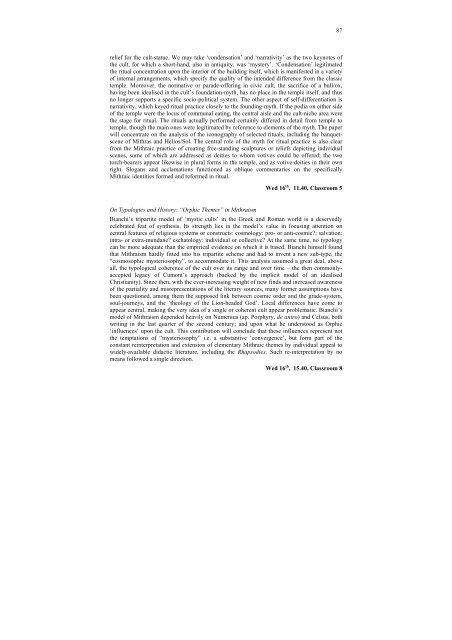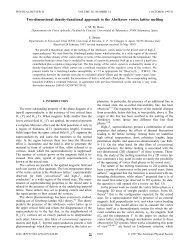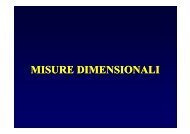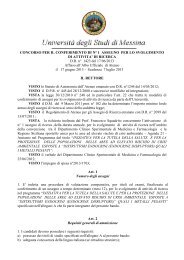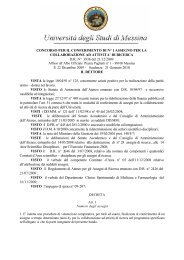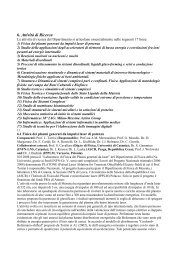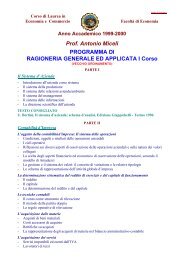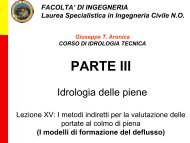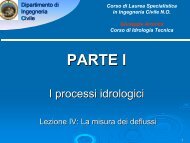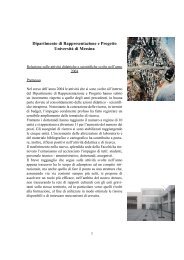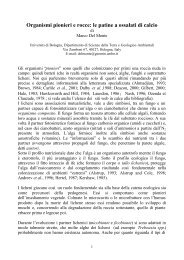PROGRAMME AND ABSTRACTS - Università degli Studi di Messina
PROGRAMME AND ABSTRACTS - Università degli Studi di Messina
PROGRAMME AND ABSTRACTS - Università degli Studi di Messina
Create successful ePaper yourself
Turn your PDF publications into a flip-book with our unique Google optimized e-Paper software.
elief for the cult-statue. We may take ‘condensation’ and ‘narrativity’ as the two keynotes of<br />
the cult, for which a short-hand, also in antiquity, was ‘mystery’. ‘Condensation’ legitimated<br />
the ritual concentration upon the interior of the buil<strong>di</strong>ng itself, which is manifested in a variety<br />
of internal arrangements, which specify the quality of the intended <strong>di</strong>fference from the classic<br />
temple. Moreover, the normative or parade-offering in civic cult, the sacrifice of a bull/ox,<br />
having been idealised in the cult’s foundation-myth, has no place in the temple itself, and thus<br />
no longer supports a specific socio-political system. The other aspect of self-<strong>di</strong>fferentiation is<br />
narrativity, which keyed ritual practice closely to the foun<strong>di</strong>ng-myth. If the po<strong>di</strong>a on either side<br />
of the temple were the locus of communal eating, the central aisle and the cult-niche area were<br />
the stage for ritual. The rituals actually performed certainly <strong>di</strong>ffered in detail from temple to<br />
temple, though the main ones were legitimated by reference to elements of the myth. The paper<br />
will concentrate on the analysis of the iconography of selected rituals, inclu<strong>di</strong>ng the banquetscene<br />
of Mithras and Helios/Sol. The central role of the myth for ritual practice is also clear<br />
from the Mithraic practice of creating free-stan<strong>di</strong>ng sculptures or reliefs depicting in<strong>di</strong>vidual<br />
scenes, some of which are addressed as deities to whom votives could be offered; the two<br />
torch-bearers appear likewise in plural forms in the temple, and as votive-deities in their own<br />
right. Slogans and acclamations functioned as oblique commentaries on the specifically<br />
Mithraic identities formed and reformed in ritual.<br />
On Typologies and History: “Orphic Themes” in Mithraism<br />
87<br />
Wed 16 th , 11.40, Classroom 5<br />
Bianchi’s tripartite model of ‘mystic cults’ in the Greek and Roman world is a deservedly<br />
celebrated feat of synthesis. Its strength lies in the model’s value in focusing attention on<br />
central features of religious systems or constructs: cosmology: pro- or anti-cosmic?; salvation:<br />
intra- or extra-mundane? eschatology: in<strong>di</strong>vidual or collective? At the same time, no typology<br />
can be more adequate than the empirical evidence on which it is based. Bianchi himself found<br />
that Mithraism hardly fitted into his tripartite scheme and had to invent a new sub-type, the<br />
“cosmosophic mysteriosophy”, to accommodate it. This analysis assumed a great deal, above<br />
all, the typological coherence of the cult over its range and over time – the then commonlyaccepted<br />
legacy of Cumont’s approach (backed by the implicit model of an idealised<br />
Christianity). Since then, with the ever-increasing weight of new finds and increased awareness<br />
of the partiality and misrepresentations of the literary sources, many former assumptions have<br />
been questioned, among them the supposed link between cosmic order and the grade-system,<br />
soul-journeys, and the ‘theology of the Lion-headed God’. Local <strong>di</strong>fferences have come to<br />
appear central, making the very idea of a single or coherent cult appear problematic. Bianchi’s<br />
model of Mithraism depended heavily on Numenius (ap. Porphyry, de antro) and Celsus, both<br />
writing in the last quarter of the second century; and upon what he understood as Orphic<br />
‘influences’ upon the cult. This contribution will conclude that these influences represent not<br />
the temptations of “mysteriosophy” i.e. a substantive ‘convergence’, but form part of the<br />
constant reinterpretation and extension of elementary Mithraic themes by in<strong>di</strong>vidual appeal to<br />
widely-available <strong>di</strong>dactic literature, inclu<strong>di</strong>ng the Rhapso<strong>di</strong>es. Such re-interpretation by no<br />
means followed a single <strong>di</strong>rection.<br />
Wed 16 th , 15.40, Classroom 8


